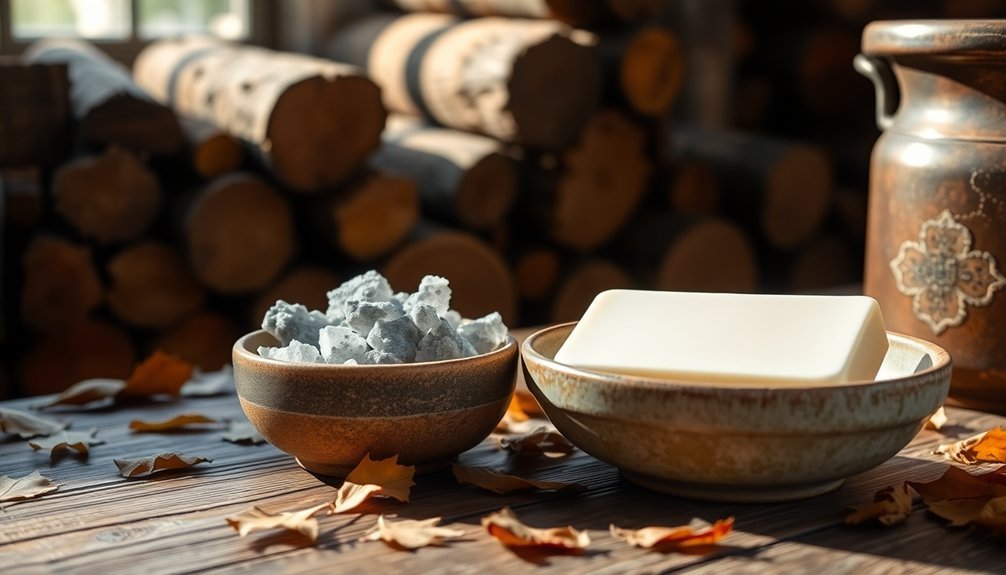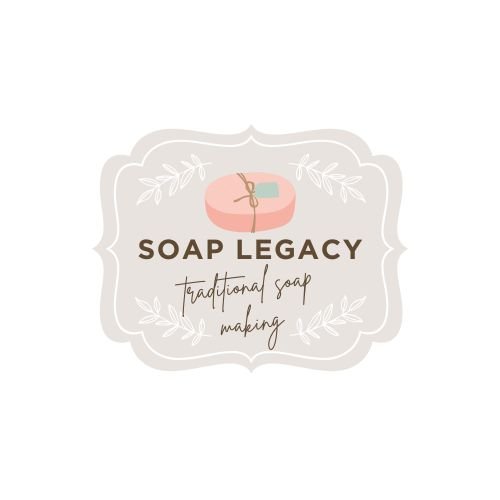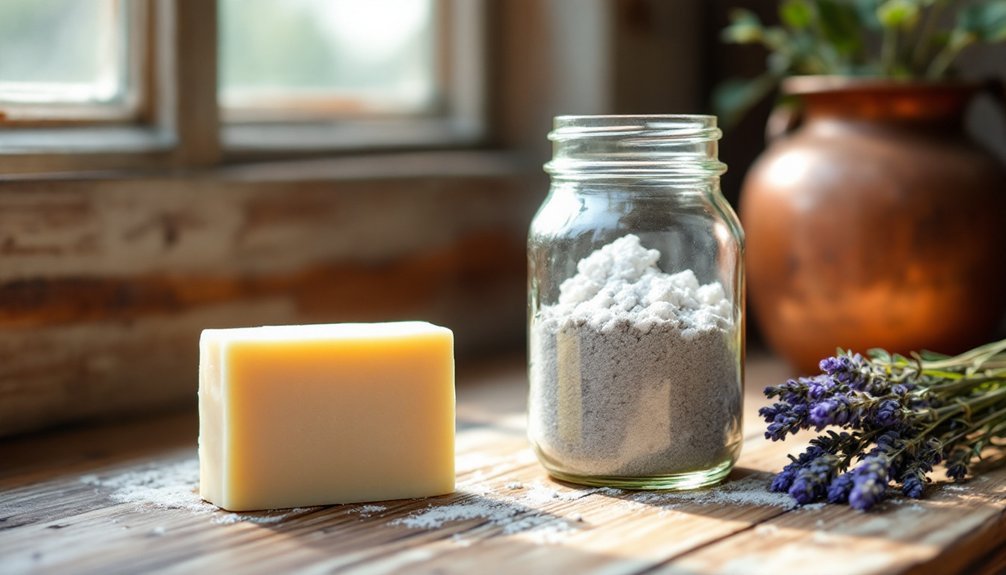Wood ash lye soap offers you a sustainable way to transform your fireplace waste into a valuable cleaning product. You'll connect with centuries of ancestral wisdom while creating gentle, chemical-free soap that's both cost-effective and environmentally friendly. It's perfect if you're seeking self-sufficiency, as hardwood ashes contain natural potassium and calcium that create rich, nourishing soap. Discover how this traditional craft can enhance your modern homesteading journey.
The Historical Significance of Wood Ash Soap

While modern soap-making relies heavily on commercial ingredients, wood ash soap represents one of humanity's earliest ventures into personal hygiene and cleaning.
When you explore its historical significance, you'll find that wood ash lye was a cornerstone of traditional soap-making throughout Europe and North America until the 1900s.
Your ancestors mastered the art of self-sufficiency by transforming simple hearth ashes into valuable cleaning agents. They'd steep wood ashes in water to extract potash, creating softer soaps that served their daily needs.
This resourcefulness showcases how communities once thrived using natural ingredients readily available in their environment.
You're connecting with centuries of practical wisdom when you choose wood ash soap, embracing a heritage of sustainable living that predates today's commercial alternatives.
Environmental Benefits of Wood Ash Lye

When considering sustainable soap-making options, wood ash lye stands out as an environmentally conscious choice that transforms waste into valuable resources.
By choosing wood ash lye, you're embracing environmental stewardship and greatly reducing your carbon footprint compared to commercial alternatives.
Here's why wood ash lye makes such a powerful impact:
- You're actively recycling byproducts from wood-burning processes that might otherwise go to waste.
- You're supporting a circular ecological system where leftover ash enriches soil with essential nutrients.
- You're reducing reliance on resource-intensive synthetic chemicals.
The practice of making lye from wood ash exemplifies true sustainability in action.
You'll connect with local, renewable resources while participating in a self-sufficient tradition that preserves our environment for future generations.
Selecting the Right Wood for Ash Production

When choosing wood for lye soap production, you'll get the best results from hardwoods like hickory, sugar maple, and beech, which yield up to 1.5% ash by weight compared to softwoods' lower output.
You should always look for clean, light-colored ash, as dark or contaminated ash will produce weaker lye solutions that compromise your soap quality.
Since hardwoods contain higher levels of essential minerals like potassium and calcium, you'll want to burn them at lower temperatures to preserve these valuable components for ideal lye production.
Hardwoods Versus Softwoods
Because the success of your lye soap depends heavily on the quality of wood ash you use, selecting the right type of wood is essential.
When choosing between hardwoods and softwoods, you'll find that hardwoods are your best option for lye production. Hardwoods like hickory, sugar maple, and oak deliver superior potassium content, averaging 2.6% by weight, which is vital for effective saponification.
Here's why you'll achieve better results with hardwoods:
- They produce 0.5% to 1.5% more wood ash by weight than softwoods
- Their higher density creates purer, more potent lye for soap making
- They contain fewer resins, resulting in cleaner ash and better-quality soap
Remember to burn your hardwoods at lower temperatures to preserve potassium content, and avoid using dark or impure ash that could compromise your final product.
Ash Color Matters Most
Beyond selecting the right wood type, the color of your wood ash serves as the most reliable indicator of its soap-making potential.
You'll want to look for white or light-colored ash, as it contains higher concentrations of potassium carbonate, which is essential for effective lye production. Dark or black ash typically indicates the presence of unburnt carbon and impurities that'll compromise your lye quality.
To achieve the ideal ash color, you'll need to maintain high combustion temperatures during burning, as this helps eliminate excess carbon.
Before starting your soap making process, make sure to sift your ash carefully to remove any remaining impurities.
Essential Tools and Safety Equipment

Since making lye soap from wood ash involves handling caustic materials, you'll need specific tools and safety equipment to protect yourself.
Start with a sturdy bucket for mixing your lye solution, and always wear rubber gloves and goggles to prevent dangerous burns. Keep vinegar nearby as a neutralizing agent for emergencies.
Your essential safety measures will make the difference between a successful soap-making experience and a potentially dangerous situation. Remember these vital points:
- Never use aluminum containers – they'll react with the lye solution
- Always have protective gear on before handling any materials
- Keep your work area clear and organized to prevent accidents
Additional tools you'll need include a flour sifter for ash separation, a mixing stick, and a watering can for creating your lye slurry.
Following proper safety measures guarantees you'll create your soap confidently and safely.
The Chemistry Behind Wood Ash Lye

While the art of soap-making dates back centuries, understanding wood ash lye's chemical composition helps you create better soap.
When you leach wood ash with distilled water, you're extracting powerful alkaline compounds, primarily potassium carbonate and sodium carbonate, which are essential for saponification.
Your wood ash contains about 2.6% potassium by weight, along with calcium, magnesium, and trace elements like sulfur and phosphorus.
These elements contribute to the chemical reaction that transforms fats into soap. When you combine the alkaline lye solution with fats, you'll trigger saponification, producing both soap and glycerin.
You'll get the best results using hardwoods, as they typically yield higher concentrations of the alkaline compounds you need for effective soap-making.
This natural chemistry makes wood ash lye an excellent choice for traditional soap crafting.
Step-by-Step Ash Collection Process
Starting your wood ash collection requires three key steps to guarantee high-quality lye production.
Begin with controlled combustion of hardwoods like hickory, sugar maple, or beech, which yield the highest ash content. Once you've burned your wood, wait for the ashes to cool completely before collecting them.
The success of your lye production depends on these vital factors:
- Choose premium hardwoods that produce 0.5% to 1.5% ash by weight
- Sift your ashes through a flour sifter to remove unburnt chunks
- Store your sifted wood ash in a dry, clean five-gallon bucket
When sifting ashes, inspect them carefully for remaining carbon pieces.
You'll want to keep the fine, white ash separate from larger chunks. Proper storage conditions in a moisture-free environment will preserve your wood ash's quality until you're ready to start making lye.
Building Your Leaching System
Now that you've gathered and stored your wood ash properly, it's time to build an effective leaching system. Start by selecting a wooden or steel barrel and drilling holes in its bottom.
Layer pebbles and straw inside, then add your hardwood ashes, creating a depression at the top for better water distribution.
Position your barrel above ground with a collection trough underneath. For stronger lye production, use ashes from hardwoods like hickory, sugar maple, ash, beech, or buckeye. These woods consistently produce more potent solutions than softwoods.
Testing Lye Concentration Methods
How can you be sure your lye solution is strong enough for soap making? Testing lye concentration requires reliable methods, and the egg calibration method stands out as your most effective option. When a fresh egg floats halfway in your lye solution, you've achieved the right strength for soap making.
- Watch carefully – if your egg sinks, your solution's too weak, and you'll need to continue boiling or processing.
- Trust the time-tested float an egg method – generations of soap makers have relied on this simple yet effective technique.
- Avoid depending solely on pH testing – it won't give you accurate measurement of alkali concentration.
While you can try alternative methods like floating potatoes or dissolving feathers, these aren't as reliable as the egg calibration method for determining proper lye strength.
Troubleshooting Common Ash Lye Issues
When making soap with wood ash lye, you'll likely encounter several common challenges that can affect your final product.
To guarantee proper lye strength, test your solution with an egg – it should float halfway above the water. If it sinks, your solution's too weak for effective saponification.
Watch out for impurities in your wood ash source. Only use white ash from well-burned hardwoods to maintain consistent quality.
If your soap texture isn't right, you're probably using incorrect fat-to-lye ratios. Try using soap calculators to determine precise measurements for your specific fats.
When soap doesn't reach trace, check your lye strength and adjust accordingly.
While wood ash lye is traditional, it can be unpredictable. Consider using commercial lye for larger batches, saving your wood ash experiments for smaller projects.
Combining Wood Ash Lye With Natural Fats
Successfully combining wood ash lye with natural fats requires precise measurements and careful selection of ingredients to achieve proper saponification. When you're working with wood ash-derived potassium carbonate, you'll need to maintain a 60:40 ratio of fats to lye solution for ideal results in your soap making process.
- You'll experience the satisfaction of creating softer, creamier soaps when using wood ash lye, perfect for liquid formulations.
- You'll connect with centuries of traditional craftsmanship by selecting hardwoods for stronger lye solutions.
- You'll discover how different natural fats, from rendered pork fat to coconut oil, create unique textures and lathering properties.
Remember to carefully measure your ingredients, as potassium-based soaps require precise calculations to prevent excess lye while ensuring complete saponification.
Proper measurement is essential in potassium soap making – precise ratios prevent lye excess while achieving complete saponification.
This attention to detail will result in high-quality, naturally derived soap.
Curing and Storing Your Wood Ash Soap
The proper curing and storage of your wood ash soap determines its final quality and longevity. After pouring your wood ash lye soap mixture into molds, you'll need to let it cure for 4-6 weeks. This vital period allows the saponification process to complete, resulting in a gentler product for your skin.
Place your soap in a cool, dry area with good air circulation during the curing phase. This prevents unwanted moisture retention and guarantees proper hardening.
Once cured, cut your soap into bars and store them in a dark location away from direct sunlight and humidity. Don't forget to label each batch with the production date – properly stored wood ash soap can last over a year.
These storage practices will help maintain your soap's lathering qualities and extend its shelf life.
Traditional vs. Modern Lye Production
Throughout history, soap makers have witnessed a dramatic shift from traditional wood ash lye production to modern chemical methods.
While traditional lye production involved leaching wood ashes to create a potassium carbonate solution, modern methods rely on sodium hydroxide for consistency.
You'll notice significant differences between these approaches:
- The natural unpredictability of wood ash composition creates a softer, more rustic soap that connects you to ancestral crafting traditions.
- The trial and error process of traditional soap making fosters a deeper understanding and appreciation of the art.
- Modern methods' precise measurements might feel less authentic but offer reliability and consistency in your final product.
Today, you can choose between embracing historical techniques or opting for modern convenience – each approach offers unique benefits for your soap-making journey.
Cost Savings of Wood Ash Soap Making
You'll discover significant savings when making lye soap with wood ash, as this readily available material costs nothing if you're already burning hardwood for heat or cooking.
The initial equipment investment is minimal, requiring only basic items like buckets, strainers, and protective gear that you can use repeatedly for future batches.
Free Raw Materials Available
Making soap with wood ash offers significant cost advantages since this raw material is freely available from home fireplaces and wood stoves.
You'll save around $4 per pound by not purchasing commercial lye, while also using a sustainable resource that's literally free for the taking. The potassium carbonate in wood ash provides the essential alkaline compounds needed for successful soap making.
Here's why wood ash is your ideal free resource:
- You're turning what would be waste into a valuable soap-making ingredient, making your process completely cost-effective.
- You'll harvest 0.5% to 1.5% usable lye material from hardwood ash, ensuring a steady supply for your soap production.
- You're creating an eco-friendly product while eliminating the need to purchase commercial lye, making your soap truly sustainable.
Minimal Equipment Investment Required
Beyond the free raw materials, wood ash soap making stands out for its remarkably low startup costs.
You'll only need basic household items like a bucket, mixing spoon, and pot to begin your lye soap making journey, unlike expensive commercial setups that can strain your budget.
Traditional soap making with wood ash is invigoratingly simple and cost-effective.
You won't need advanced technology or specialized equipment to transform natural materials into quality soap. The process relies on readily available items, making it perfect if you're watching your expenses.
Since distilled water is inexpensive and wood ash is often a free byproduct of your fireplace, you can start soap production without a significant financial investment.
This approach not only saves you money but also supports sustainable practices by recycling materials you'd otherwise discard.
Reduced Household Waste Expenses
While commercial soap making can strain your budget, creating lye soap from wood ash offers substantial cost savings through waste reduction.
By transforming wood ash from your fireplace into a valuable soap ingredient, you'll reduce household waste while crafting a budget-friendly alternative to store-bought products.
Consider these compelling benefits:
- You'll save $4-$10 per pound by avoiding commercial lye purchases
- You'll minimize expenses by using free wood ash instead of disposing it
- You'll achieve greater self-sufficiency while cutting personal care costs
The process requires only distilled water and fat alongside your recycled wood ash, making it exceptionally cost-effective.
This practical approach to soap making not only helps your wallet but also promotes sustainable living through smart resource utilization, proving that reducing waste can directly impact your household expenses.
Frequently Asked Questions
Why Is Wood Ash Used in Soap Making?
You'll find wood ash is perfect for soap making because it naturally contains alkaline compounds like potassium and sodium carbonates. It'll create gentler soap than commercial lye while promoting sustainability through waste recycling.
What Are the Best Ashes for Soap Making?
You'll get the best soap-making results using hardwood ashes from hickory, sugar maple, ash, beech, and buckeye. These woods produce higher quality lye with concentrated potassium carbonate compared to softwoods.
What Wood Is Best for Lye?
For the best lye, you'll want to use hardwoods like hickory, sugar maple, ash, beech, and buckeye. They'll give you higher ash yields (0.5-1.5% by weight) compared to softwoods, producing stronger, higher-quality lye.
Can You Make Lye From Any Ash?
No, you can't use just any ash. You'll need hardwood ashes like oak, hickory, or maple for the best lye. These woods contain higher potassium levels, while softwoods and marine plants won't work effectively.
In Summary
Making your own wood ash soap connects you to an ancient craft while providing modern benefits. You'll reduce waste, save money, and create a truly natural product. Whether you're a homesteader or eco-conscious consumer, wood ash soap making lets you control ingredients while honoring traditional methods. By choosing wood ash lye, you're embracing sustainability and self-reliance in your personal care routine.





Leave a Reply